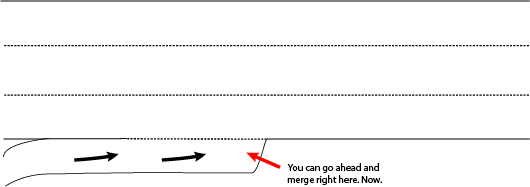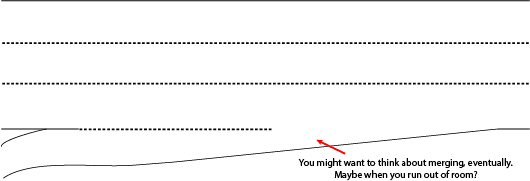It’s taken me a while to get my head wrapped around this, but finally, here it is: why the US fails at zipper merges. Surprise, it’s not entirely the fault of our poorly-trained drivers.
I noticed this when I was living in Germany – the zipper merge (all traffic uses both lanes prior to the merge point and lanes take turns merging) is smooth and seamless (ha ha) over there. It just works. In the US, you find two behaviours – either the drivers merge into one lane long before the merge point and drivers are incensed at those who use the free lane, or the drivers use both lanes, but do not take turns. Both behaviours are wrong and at best slow traffic, at worst lead to road rage and/or accidents.
However, I’m not in a hurry to blame America’s drivers for this one. Instead, I’m going to blame our traffic engineers. Let’s have a look at the typical road markings for merge lanes in both the EU and the US. Lane 1 is at the top, and the merging lane is at the bottom.
In the EU, well, Germany at least, the merging lane is full-width until the merge point, at which it very abruptly ends. The drivers are reminded to think about merging by a few arrows painted in the lane. The lane reduction zone is usually around 5m long, so not much time to think about it – you just take turns and move on with life. The dotted line between the merging lane and the through lane is usually about five to ten car-lengths long.
In the US, the merge lane gradually narrows over (usually about) a quarter mile, gently nudging cars over. The dotted line often disappears when the merging lane is less than half of a normal lane width, further complicating the marking. This can create additional confusion about when particular vehicles should actually complete the merge.
The difference between the two is that the EU markings clearly indicate that the lane is ending at a fixed point, while the US markings allow the lane to continue to exist for various lengths depending on vehicle width. This confuses the issue of when exactly to merge, because let’s face it, if you are smart, you don’t merge until you have to. The confusing lane markings mean SUVs have to merge before motorcycles do, and most drivers will posit that that is hardly fair! On the other hand, if you’re one of those early mergers, you don’t even realize that you could use the whole lane, because it disappears in such a tricky manner and you want to avoid that ambiguity at all costs. Which you do by merging early and blocking up traffic for everyone. The worst cases are those drivers who are sadly so confused that they opt to drive in both lanes (halfsies!) and block both of them to forward progress.
Although I’ve drawn the roads as entrance ramps, this exact setup works (in both cases) the same for regular lane reductions due to construction, road use, etc.
The Federal DOT could do us all a favor and modify their guidelines for merge lane markings. The clearer EU setup not only promotes the zipper merge through logical markings, but also subtly discourages lane straddling. Coupled with a bit of driver education, this change could zip up one of the most annoying road issues we have to face today.


